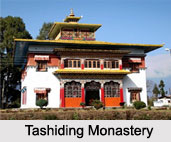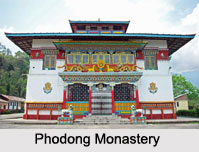 Monasteries of Sikkim are popular place of worship for the Buddhist monks who reside in Sikkim. These monasteries mainly follow the Nyingma and Kagyu order of Buddhism. There are about 200 big and small monasteries which not only depict the cultural heritage and life style of Buddhists in Sikkim but also preach the ancient rituals of Buddhism. These are mainly established by the well known and most revered monks who lay the foundation of these monasteries.
Monasteries of Sikkim are popular place of worship for the Buddhist monks who reside in Sikkim. These monasteries mainly follow the Nyingma and Kagyu order of Buddhism. There are about 200 big and small monasteries which not only depict the cultural heritage and life style of Buddhists in Sikkim but also preach the ancient rituals of Buddhism. These are mainly established by the well known and most revered monks who lay the foundation of these monasteries.
Monasteries of Sikkim are mainly known for upholding the tradition folk culture through the monk dances and mask dances that take place according to the calendar of ancient Tibet. Decorated with frescos of Buddhist legends, rare silk and brocade fabric are some of the most colourful sites in Sikkim. Established during the 17th and 18th century these monasteries are mainly known for their architecture as well as their religious practices.
Different Monasteries of Sikkim
Monasteries of Sikkim mainly follow the Nyingma and Kadyug order. This relates Sikkim with ancient Tibet. Among these Nyingma is among the four ancient Schools of Tibetan Buddhism. Following are the popular monasteries of Sikkim:
Rumtek Monastery: Rumtek Monastery is one of the major and most significant monasteries in Asia which is situated next to the capital city of Gangtok. It is the best model of Tibetan architecture in India.
Tashiding Monastery: The Monastery is part of Buddhist spiritual pilgrimage journey in Sikkim. Tashiding Monastery is the most stunning Monastery of North East India, located on top of the hill rising between the Rathong chu and the Rangeet River.
 Enchey Gompa: The monastery has a big assortment of masks and Cham dance festival celebrates here each year. Enchey Monastery is one of the olden religious sites of the Buddhists in the state of Sikkim which was built around the then small hamlet of Gangtok.
Enchey Gompa: The monastery has a big assortment of masks and Cham dance festival celebrates here each year. Enchey Monastery is one of the olden religious sites of the Buddhists in the state of Sikkim which was built around the then small hamlet of Gangtok.
Dubdi Monastery: Dubdi Monastery is also called as Yuksom Monastery, situated in the Geyzing part. Yuksom Monastery is the oldest monastery in Sikkim and strongly linked to the founding of the State.
Pemayangtse Monastery: The monastery is located at a height of 2085m and offers wonderful panoramic view of the Himalayan snow-capped mountains and Kanchenjunga peak. Pemayangtse Monastery is situated on a hill top near Pelling and one of the foremost monasteries of Sikkim.
Ralong Monastery: Ralang Monastery is situated near the celebrated tourist destination of Ravangla, in the southern portion of Sikkim. This interesting old monastery is acclaimed to be the biggest monastery of Sikkim.
Phodong Monastery: This monastery was built by the Chogyal Gyurmed Namgyal somewhere in the first part of the eighteenth century in Phodong in North Sikkim. It belongs to the Kagyupa Sect and it is said to be the first Kagyupa monastery to be set up in Sikkim. It is celebrated for its elegantly fine mural painting and frescoes.
Sang Monastery: Sang monastery is one of the oldest monasteries in Sikkim and was built in 1912 AD by Sang Athing, a landowner. There is a hand impression of Phaya Lama in the monastery interiors which is one of the great teachers of Sang monastery.
Monasteries of Sikkim include Khechopari monastery, Melli monastery, Sinon monastery, Dalling monastery, Yangyang monastery, Namchi monastery, Kwezing monastery, Simik monastery, Hee Gyathang monastery, Lingtem monastery, Chawang ani monastery, Rhenock monastery, Khatok monastery, Bermoik monastery, Lachen monastery, Lachung monastery, which were established slowly and gradually in the following years.



















